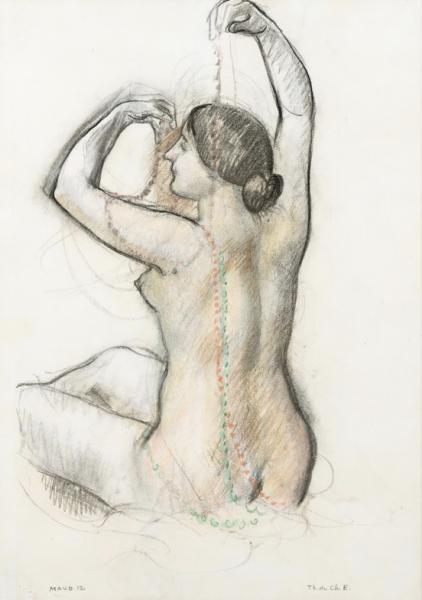La Péri, étude. Projet pour le théâtre des Champs-Elysées, 1912
Charcoal and pastel on paper, monogrammed and dated 12 lower left, annotated "Th. des Ch. E." at the bottom right.
60.50 x 43 cm
Preparatory drawing for the panel of the Lyric Drama (decoration of the frieze of the dome of the Théâtre des Champs-Elysées, 1912).
Certificate of authenticity established by Madame Claire Denis.
The decoration of the frieze of the dome of the Théâtre des Champs Elysées by Maurice Denis
In 1908, the art-loving financier (and cousin of Berthe Morisot) Gabriel Thomas asked his friend Maurice Denis to create a large decoration for the dining room of his home in Meudon. This is how L'Eternel Printemps, a decorative set of ten painted panels representing an ideal earthly garden populated by muses, came into being.
Some time after this commission, Gabriel Thomas solicited the artist again for a more ambitious project. He was one of the promoters of the Théâtre des Champs-Elysées, a bold and innovative building, mainly in reinforced concrete, designed by the architects Auguste and Gustave Perret. The hall is dominated by a large dome and Thomas wanted to entrust the painted decor of the latter to Maurice Denis.
This commission, which was completed in 1912, represented nearly 300 meters of curved walls for the painter to cover, a frieze topped by a monumental chandelier from the Baguès company (in collaboration with the ironworker Perrassy), which also acted as an acoustic trap.
Music played an important role in Maurice Denis' life (his wife was a musician and the couple surrounded themselves with composer and musician friends) and he naturally chose to illustrate a History of Music in several paintings.
Four themes are represented in the spandrels: the Organ, the Orchestra, the Choir and the Sonata.
Four illustrated phrases join them: The Greek Orches, The Opera, The Symphony and The Lyric Drama, in an idea of musical continuity, linking the past to the present, the particularity of this frieze being that Maurice Denis conceived it as being read not in a horizontal direction but according to a cruciform plan.
Facing the audience, above the stage, one reads:
"To the Dionysian rhythms uniting the Word of Orpheus, Apollo orders the games of the Graces and the Muses";
to the left and right of the stage, one can respectively read "From the heart of Man, from all the voices of nature, springs the symphony" and
"The Architecture of the Classical Opera ennobles the passions and the tragic destinies",
while, behind the audience, the following inscription is revealed:
"On the peaks in anguish and dream, lyrical drama or poem, Music strives towards a pure ideal".
It is from this last illustration that our character is taken. More precisely, the study that has come down to us is one of the female characters in the foreground of this composition. This character has been identified as the ballerina Natacha Trouhanova, friend and model of the painter, in her role of "La Péri" for the eponymous ballet by Paul Dukas.
"A Péri, whose model was Trouhanova, cascades pearls down her torso, the graphic equivalents of the trickles of rare timbres, the glittering tones of Ravel and Debussy." (S. Barazzetti, Maurice Denis, Grasset, 1945, p.163-164). A peri designates, in the Persian tales, a chimerical female genius, often winged.
Here, Maurice Denis represents a character of flesh and bone, of a sensual femininity, nets of pearls cascading on her naked back.

